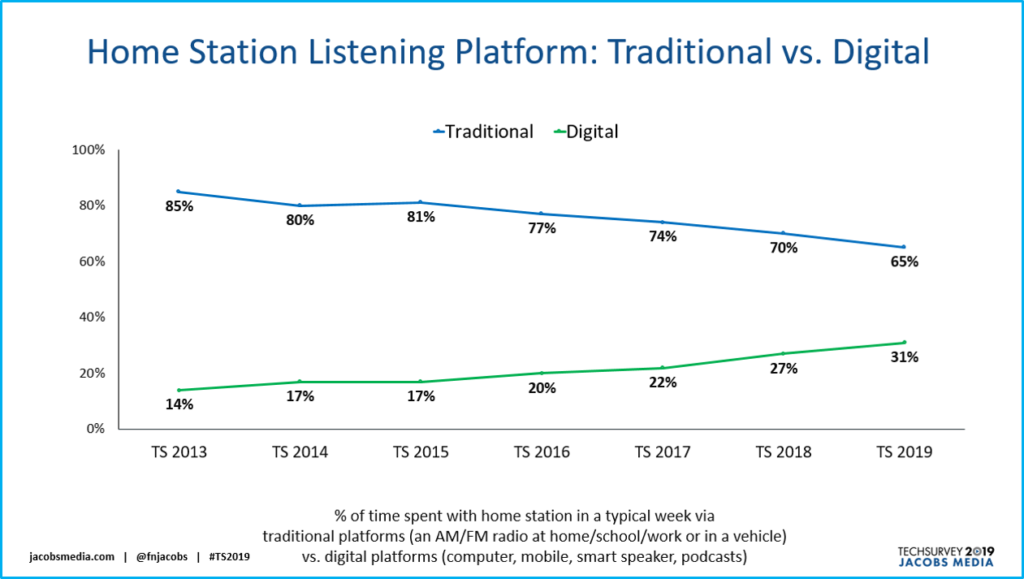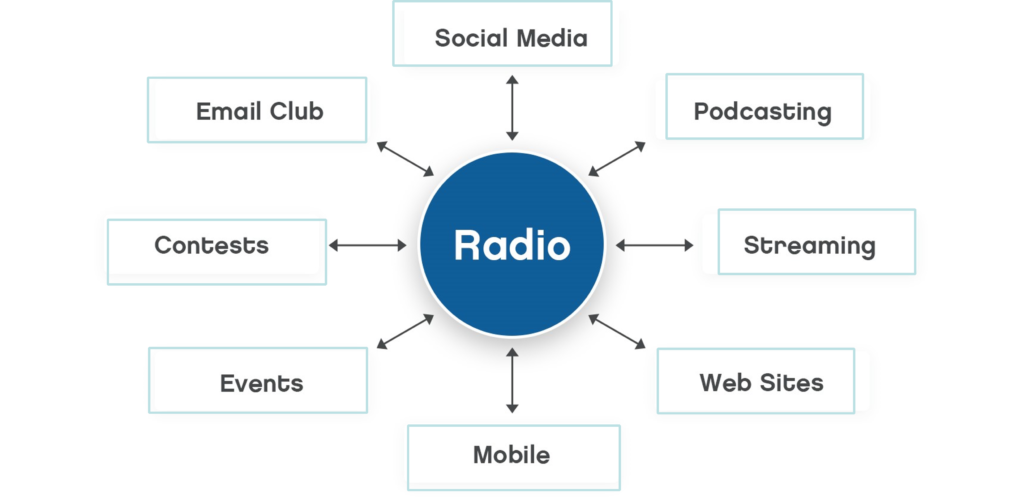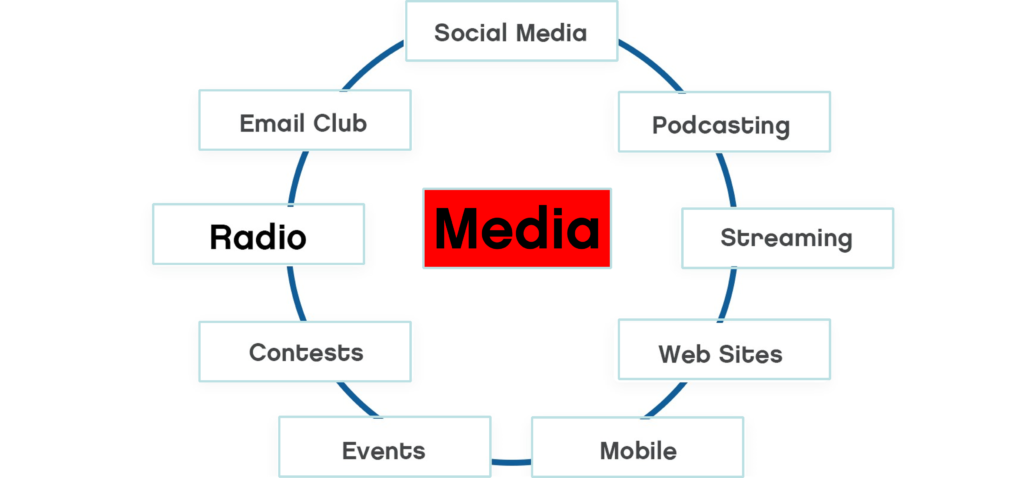
Transformation is one of the big buzzwords that you hear bandied about a lot these days in radio. It’s about how the industry shifts its focus to keep pace with the changing worlds of media content and distribution.
While many radio companies are struggling with this challenge, the transition on the part of the audience and advertisers is well underway. Digital is moving closer and closer to becoming a mainstream pathway in which people consume media content, as well as the place where marketers are placing their bets.
We’ll all seen the reach data from Nielsen (and other sources) enough to know that broadcast radio has actually hung in very well, especially given the torrent of new media platforms.
But the toothpaste is, in fact, out of the tube. Even core radio listeners – like the 50,000+ who participated in our Techsurvey last winter – are shifting the ways in which they consume our stations – whether we encourage them to do or not.
We ask respondents to think of the way they listened to the station that sent them the survey during the previous week, listing all the traditional outlets (car radio, radio at work, etc.) as well as the digital distribution outlets (streaming, apps, podcasts, etc.). And we chart the ratio between “traditional” – listening on a regular radio – versus “digital” – using the stations content on digital outlets.
When you consider the long-term trend – and the chart below tracks the last seven years – the directionality of where we’re headed is indisputable. Transformation is in the air.

This is precisely why we’re examining the topic of transformation in the opening general session of the Radio Show next week in a presentation called “You’re Not Just In The Radio Business Anymore.” We’re excited about how it’s coming together and we’ll have more details about our speakers and how they’ll paint their own pictures of how transformation is working for their companies soon.
What we’ve learned over the past few years in helping guide traditional media companies through the morass of key strategic decisions that need to be made is that transformation is both digital and analog. A few weeks ago, we quoted Nancy Lyons, head of Clockwork who addressed these same challenges at the Public Radio Program Directors Content Conference in Minneapolis. Companies need to not just make the required technical improvements and investments, but also must address the human side of change with their staffs – many of whom are skeptical or wondering how they will be incentivized and compensated in the digital media ecosphere.
But those are the practical speed bumps. Often the challenge is one of mindset. It’s one thing for companies to launch new initiatives. It’s another when there is pushback, resistance, and even resentment about transformation within the ranks. Even as new initiatives have been launched, many in radio still perceive their worlds with radio holding onto its position as center of the universe. Other distribution outlets are thought of as more like satellites, secondary players in the big picture of how content is consumed:

While many older, traditional listeners may see their favorite radio station this way, increasing numbers of consumers – yes, younger ones – are more likely to be platform agnostic. That is, they connect with stations in a myriad of ways, via channels that suit them, wherever they are, whatever they have available to them, and in whatever situation they find themselves.
The most habitual listeners have always played contests and attended station events. But now even some of these very “old school” fans have figured out how to stream, they download apps, they regularly visit websites, and many are buying smart speakers.
Some of the media carnivores in a station’s cume are more likely to view the station in a different way. While they may still tune in on regular radios – especially in cars where they are still ubiquitous – they continue to gravitate to other devices and different ways to connect with radio brands.

This new paradigm still depicts radio as a key player in the distribution mix, but becoming one of many distribution outlets for consumers to choose from on whatever platform they prefer or situation they happen to be in.
At least, that’s the hope. Because when people buy a smartphone, an Amazon Echo, or start listening to podcasts, the goal would be for them to easily and seamlessly find your brands in these new media places. If not, they’ll find someone else’s content in those same locations.
This is why it is critically important for radio staffs to understand the changing rules of the digital road, and shape their messaging accordingly. ![]() Whether you’re the person writing promos, you’re on the air communicating directly with the audience, you’re part of the sales team marketing these assets to advertisers, or you’re the receptionist fielding questions from listeners, it’s of paramount importance that everyone’s on board with a firm understanding of the big picture.
Whether you’re the person writing promos, you’re on the air communicating directly with the audience, you’re part of the sales team marketing these assets to advertisers, or you’re the receptionist fielding questions from listeners, it’s of paramount importance that everyone’s on board with a firm understanding of the big picture.
And so often inside radio stations these days, corporate is pulling the levers of change, but execution and buy-in at the local market level may be spotty and even skeptical. That’s why a content strategy goes a long way toward creating successful transformation.
It’s about communicating the rationale to staffers, and then giving them the tools, the budgets, and the running room to implement these changes on – and especially off – the air.
Tomorrow, we’ll look at one of radio’s key competitors – Spotify. They’re making big moves with each passing day. From partnerships to new delivery mechanisms to podcasts to on-demand, the innovation is flowing.
The question is, how are they communicating it to their various constituencies – and what can radio broadcasters learn from them?
See you tomorrow.
- Media And Technology In 2025: Believe It Or Not! - April 18, 2025
- In Radio, You Just Never Know - April 17, 2025
- The Secret To Making A Great Podcast (And Great Radio) - April 16, 2025




Fred,
I agree with what you’re saying, however I would make one suggestion. In your graphic showing “Media” at the center and all the channels orbiting, I would change “Media” to “Content”.
I’m not picking a nit here, just saying that media is the means by which we deliver content. Without content, you just have conduits and dry ones at that.
As we jumped into the digital world some 20 years ago, it took us some time to realize and then educate our staff that we aren’t in the radio business. We are in the content delivery business. We deliver it via our website AccessWDUN.com, over the air, through streaming, and through social media. This year we added print, as we published a prep football magazine (a real magazine, not a cheap tabloid) covering 24 schools in our listening area. At 100 pages it hasn’t only been a great way to connect with the community, the ad revenue was excellent.
Enjoy your insights, but just wanted to plunk my 2 cents in the plate. Until folks in our line of work realize that it’s the content that matters most, we’ll end up like newspapers who though the web was a bad idea.
Regards,
Bill Maine
Jacobs Media Corp.
WDUN AM/FM; WGGA AM; AccessWDUN.com
Bill, it’s a good point – and an ongoing topic of conversation. The radio industry is doing a much better job providing new distribution outlets. That’s good. But what’s the quality and “worthiness” of that content on apps, smart speakers, podcasts, streams. Point taken and thanks for reading our blog.
This is so GREAT.
Thanks Fred!
Gil
Thanks, Gil!